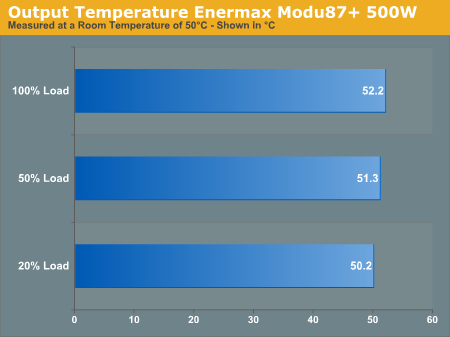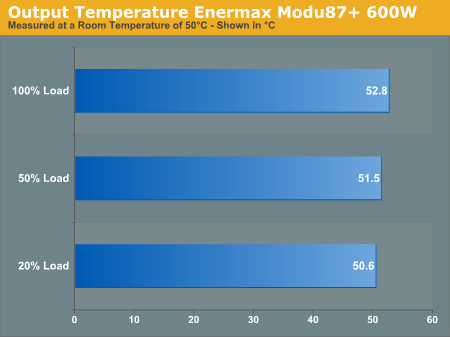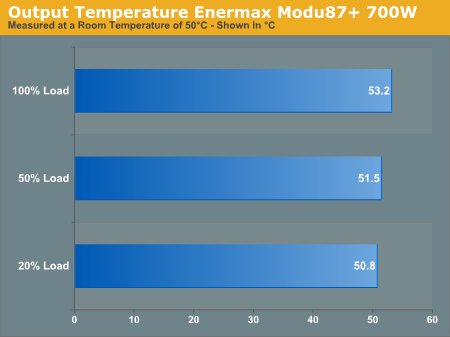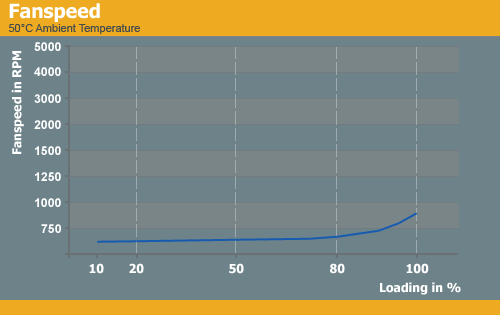Enermax Gold: Modu87+ and Pro87+
by Christoph Katzer on January 19, 2010 1:00 PM EST- Posted in
- Cases/Cooling/PSUs
Temperatures, Fan Speed, and Acoustic Noise



We have tested these units in a chamber with a constant temperature of 50°C to see if they are up to the challenge and don't blow up on us. Well, what can we say? The graphs above show the output temperature measured 1cm in front of the rear vent on each power supply. The measured temperature is just a few degrees over the input temperature. This means that the components inside produce very little heat that actually needs to be dissipated. This is related to the high efficiency these units are able to achieve, as we will see on the next page.

When you switch on these units and the fan starts turning you can actually almost see each blade while it turns. Enermax came up with a very good fan motor design and IC. The company is therefore able to lower the fan speeds to incredible 330 RPM, which is normally only possible with a PWM fan control. Enermax cannot use that approach (without paying royalties) since Antec has a patent on PWM fan controllers inside power supplies.

The low fan RPM continues through most loads, and even when we loaded the power supplies to their limits and left them running for longer periods of time we were not able to clearly hear the fans. When you put your ear close to a unit you will be able to hear a very light hum under full load but that's about it. Under lower loads you will never hear the fan and this makes these units unbeatable compared to the current competition of fan-cooled power supplies. Since all three units have the same curve we only included the 500W unit on the above graphic.










59 Comments
View All Comments
FaaR - Thursday, January 21, 2010 - link
You're too focused on price only. A PSU isn't something you buy every day. Better to get a great, efficient unit that has headroom to grow and will last you many years, even if it costs a little more.And yes, fifty bucks is a little more. Most people on Anandtech wouldn't whine if they have to pay $200 for a video card, and we all know how fast they go obsolete. Get some perspective here please.
The PSU is arguably THE most important piece of equipment in your whole PC. If it doesn't function well, nothing else will either. So there's nothing wrong with buying one of the best units out there, quite the opposite.
Kibbles - Friday, January 22, 2010 - link
Actually this is more like a $600-700 videocard amongst PSUs. Most will be happy enough with a HD5870. Many PSUs in the $100 range, like the HX620, are damn good. However like any other computer component, those extra 5% costs just as much as the first 95%.Spacecomber - Tuesday, January 19, 2010 - link
I happy to see another P/S review on Anandtech. I don't think that there have been any in quite a while. While these Enermax models are very nice, the price probably makes them impractical for any builds that I can imagine.However, one thing that I really like about these power supplies is their very low noise output. As I move away from building game-centric computers to computers that are likely to be used more as media servers, keeping the noise down to being virtually inaudiable becomes more important to me (especially for a music server). For these kind of computers I don't need a huge amount of power, and therefore I'm not looking to invest a huge amount of money in the P/S. I'm really looking for a power supply that can give me the quietest experience for the least amount of money. (To get a really quiet P/S, I accept that I'll be spending more than one would expect to spend on most "budget" power supplies.)
Anyway, this is just a suggestion that perhaps others are also looking for something more like this for their living rooms, instead of a kilowatt P/S to drive an overclocked quad core monster with multiple video cards.
- Tuesday, January 19, 2010 - link
The first three graphs on p.11 look like they need more labeling. Looks like you need to show which PSU for efficiency.mariush - Wednesday, January 20, 2010 - link
On page 10, I somehow doubt the readings were made at 50C room temperature (see chart headers)JarredWalton - Thursday, January 21, 2010 - link
As mentioned below, the tested was done in a temperature controlled chamber, so the ambient temp was indeed 50C. I would update the graphs, but Christoph custom-made these charts so I'll leave that to him. :)JarredWalton - Tuesday, January 19, 2010 - link
Fixed... the same graph was initially inserted on all three as you may have noticed.markshin - Saturday, July 24, 2010 - link
i bought a Modu87+ 700W, because i needed a new psu to replace my 5-year old 70% efficient unit..I don't intend to run this at 100% load, that's sheer madness. 30-60% is the sweet spot for today's PSU's, that's where they are most efficient.
and also, they're selling for about US$150 (at least from where I'm located).
:-)
MasonStorm@AnandTech - Friday, October 1, 2010 - link
Hi Chris,Thanks for the great review. Any chance you can update the results to include the new, 800W and 900W models they've just released? I'd love to see if those also stay silent at all loads.